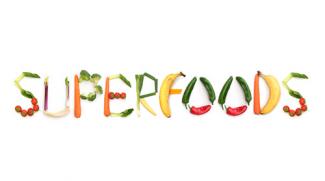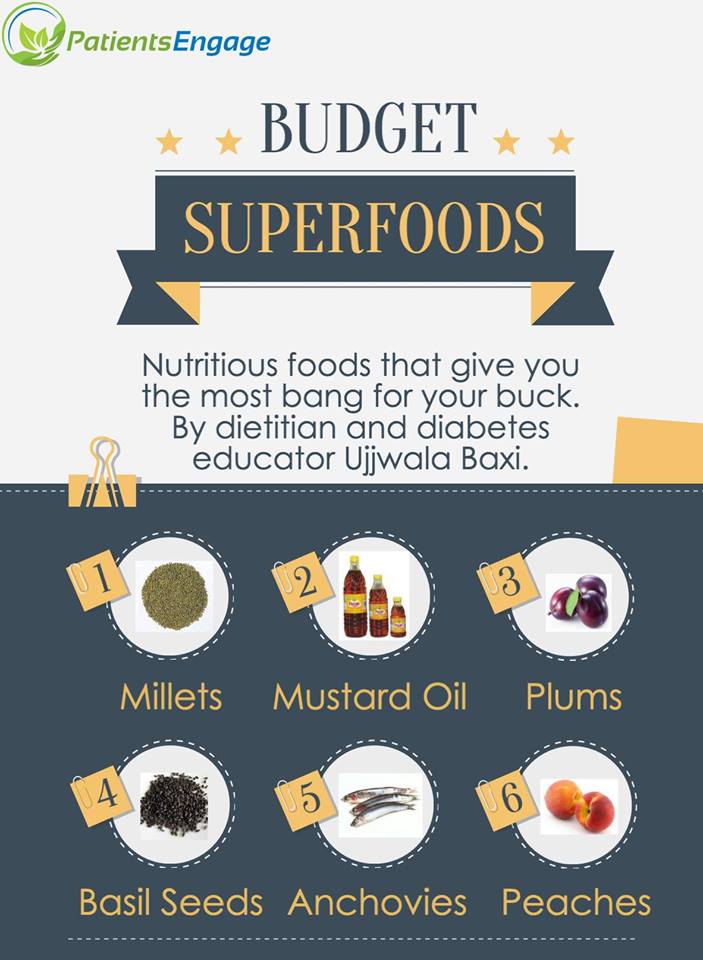
Nutritious foods that give you the most bang for your buck. By Dietitian and Diabetes educator Ujjwala Baxi
When we hear ‘superfoods’, we think quinoa, blueberries, salmon, chia seeds etc thanks to clever marketing and hype. These are not only expensive, but can be hard to get hold of, especially in India. The good news is that there are ‘superfoods’ that are readily available and affordable, but are often ignored. They pack as much punch as the much-touted superfoods but are overlooked as the marketing gurus haven’t gotten to them yet.
So power up on these 5 unsung heroes:
A. Basil seeds instead of chia seeds (Known as Sabja/falooda/takmariya seeds in India)
Basil seeds have a similar nutritional profile to chia seeds. Both are rich in fibre, omega 3 fatty acid and are cooling in nature. Basil seeds have additional essential nutrients like Vitamin K, vitamin A. They are believed to improve vision and fight against lung and oral cavity cancers. They are also high in magnesium, which relaxes the muscles and blood vessels, improving blood flow and reducing the risk of irregular heart rhythm. Like chia seeds, they also absorb liquid and swell up.
Basil seeds are a lot cheaper too – about one-fifth the price. A 100g pack of basil seeds costs only Rs. 100 (S$2) while the same amount of chia seeds cost a whopping Rs. 500 (S$10).
How to eat them
Preparing basil seeds: Put 2 tsp of basil seeds in 1/2 cup - 1 cup of warm drinking water or liquid of your choice. If you want more concentrated flavour, drain the excess water after swelling the basil seeds with plain water. Allow the mixture to stand for at least 2 minutes with the warm water/liquid to give the seeds time to absorb water and take on a gelatinous tapioca-like texture. The warm water (not boiling) helps to fully swell the basil seeds, releasing antioxidants and digestive enzymes on consumption. Soaking helps to reduce enzyme inhibitors and increase digestibility. They turn out delicious too!
Make a drink with basil seeds: Add the prepared basil seeds to your favourite liquid – be it green juice (cucumber-mint), raw coconut water, pineapple juice, organic green tea, almond milk, coconut milk or soya milk. Stir in (if you wish) raw honey, raw agave, maple syrup, lemons, ginger, and your favourite tropical fruit bits: (lychee, mango, mangosteen). Drink and chew and enjoy!
You can also mix prepared basil seeds in creamy drinks (smoothies, yoghurt, oats and cereal). Be creative, for there really is no wrong way to eat basil seeds.
Recipe: Black & White Banana Smoothie
Ingredients
Banana – 1
Yoghurt – 1 cup
Basil seeds – ½ tsp
Honey – 1 tbsp
Ice – ½ cup
Method
1. Soak basil seeds in warm drinking water for 5 minutes.
2. Put yoghurt, banana, ice and maple syrup in a blender and blend until smooth and no chunks remain.
3. In a serving glass, put soaked seeds on the bottom of the glass. Pour the smoothie and then top again with basil seeds.
4. Serve chilled and enjoy the goodness!
B. Anchovies instead of salmon (Known as Nethili, Kati, Nethalu in India)
Anchovies offer more omega-3s than wild salmon (3.4 grams versus 3.2 grams per 100 gm). Sardines and mackerel are close runners-up. They are a rich source of iron, with 20 grams of fresh fish containing 12 percent of the recommended daily intake for men and 5 percent for women. You can also eat light tuna and herring, which are easily available fresh. It is always better to choose fresh over canned as canned fish is high in sodium and BPA, which may cause blood pressure spike over a period of time.
How to eat it: Make curry, barbeque, steam or pan-fry them.
Recipe: Baked Eggs with Potato and Anchovies (serves 2)
Ingredients
2 large free range eggs
1 large tomato, cut into wedges
Half brown onion, diced
2 cloves of garlic, finely chopped
8 cocktail potatoes or 4 large potatoes, peeled and cut into chunks
1 can whole peeled tomatoes
2 tbsp tomato paste
3 tbsp vegetable stock (or 1 tbsp vegetable paste)
1 tbsp smoked paprika
1 tsp dried or fresh oregano
4-5 pieces of fresh anchovies
1 tbsp grated cheddar cheese
Salt and pepper to taste
Olive oil
Serve with pieces of Turkish or other good quality bread
Optional: You can also add in half a large capsicum, sautéed until soft.
Method
1. Pre-heat oven to 200C.
2. Wash and cut the potatoes, then boil it in a pot of water for roughly 10 minutes or until soft and cooked.
3. In the meantime, heat a pan on medium high with olive oil, cook garlic and onions until transparent.
4. Add in tomato wedges, can of tomatoes, tomato paste and stir.
5. Add in smoked paprika, oregano and stock
6. Add in potatoes when they’re done and stir through, cook for 2-3 minutes until potatoes are well coated with the sauce.
7. Put in anchovies, stirring as you add each one and tasting it as you go.
8. Salt and pepper to taste.
9. Transfer items of the frying pan to 2 oven-proof pots. Using a spoon, create a small well in the middle of the sauce and potatoes then crack an egg into the well.
10. Bake in the oven for roughly 10 minutes or until the egg white has become solid white.
11. Remove from the oven, top with grated cheese and heat for a further 1 minute or until cheese has melted.
12. Remove from the oven, top with more pepper and olive oil and serve with toasted Turkish bread.
C. Millets instead of quinoa (Jowar, bajra, ragi in India)
Urban Indians today rarely consume these economical and power-packed millets, which were part of the staple diets of our ancestors. Instead of bhakris (bread made from millets), we eat wholewheat rotis, brown rice and quinoa, which are much costlier. As compared to quinoa, millets are richer in B-vitamins such as niacin, B6 and folic acid, as well as calcium, iron, potassium, magnesium, zinc and beta carotene. Each millet variety has a different nutritional profile. They are higher in carbohydrate, fibre and protein and are gluten-free. Millets are a better food option for convalescents, pregnant women, infants and elderly. Millets also set the body's acid-alkaline balance in order and are especially rich in minerals. These properties make millets extremely healthy foods that are especially good choices for heart, gastric and diabetic patients. However, individuals with thyroid issues need to be aware of the mild goitrogenic effects of millets. Anyone without thyroid problems should be able to eat goitrogenic foods in moderation without issue. One way to offset the goitrogenic effect is to eat foods high in iodine and tyrosine along with them. Iodine-rich foods are cow’s milk, eggs, raisins and iodised salt. Foods rich in tyrosine are pumpkin seeds, beef, fish, dairy products, eggs, bananas, avocado, poultry and almonds.
How to cook millets
Millets can be eaten as a rice substitute. Wash and soak the desired amount of millets in two times the amount of water for at least 30 mins. Cook it like rice. Add a tsp of oil to prevent it from sticking while cooking. On cooking, millets become fluffy and soft. You can use millets to make the following:
- Khichdi
- Sweet porridge
- Idlis from whole jowar
- Add millets to dosa batter
- Enjoy puffed jowar as a snack, breakfast cereal or sprinkled on salads for crunch
- Use Kangni, nevane or Thennai variety of millets to upma in place of rava
- Add millet flour to rotis; for cakes and raised breads, mix them with wheat flour.
Recipe: Chilli Bajra pancakes
Ingredients
Bajra flour – 1 cup
Tomato – 1 (finely chopped)
Onion – 1 (finely chopped)
Garlic – ¼ minced
Ginger – ¼ grated
Green chillies – 2 (finely chopped)
Corriander leaves – ¼ cup
Salt – to taste
Red Chilli Powder – ½ tsp
Asafoetida – a pinch
Cumin powder – ¼ tsp
Ghee – 1 tbsp
Oil – to pan fry
Method
1. Combine all the ingredients in a bowl. Add water if needed to make a slightly sticky batter (like pancake mix).
2. Heat a non-stick skillet and lightly grease it with oil. Pour a ladle full of prepared batter and gently spread it to make a flat pancake.
3. Allow it to cook. When the edges turn slightly brown, flip over and cook again.
4. Remove from the skillet and serve hot with tomato sauce.
D. Mustard Oil instead of Olive Oil
It is not only five times cheaper, it is considered one of the healthiest edible oils as it has low amount of saturated fatty acids and a high amount of MUFA (monounsaturated fatty acids) and PUFA (polyunsaturated fatty acids). Furthermore, the Omega 6 (N-6): Omega 3 (N-3) ratio of mustard oil is near ideal 6: 5 unlike olive oil where it is ~ 20:1. It is high in antioxidants and vitamin E, and the fact that it is cold pressed adds to the nutrition value of this oil. In fact the chances of heart disease drop by nearly 70% on use of mustard oil as a cooking medium, which is better than olive oil.
How to eat it
Mustard oil can be used raw (kachi ghani) as salad dressings and added to a puffed rice snack (called ‘moori’ in West Bengal). It can also be used for cooking and making pickles.
Recipe: Moori
Ingredients
Puffed Rice – 1 cup
Mustard Oil – 1 tsp
Onion – ¼ cup
Tomato - ¼ cup
Green Chillies – ½ (chopped)
Fresh tender coconut pieces – 1 tbsp (optional)
Coriander leaves – 1 tbsp
Salt to taste
Red chilli powder – ¼ tsp
Method
Mix all the ingredients together in a bowl and enjoy.

E. Eat Plums and peaches instead of blueberries
Plums and peaches are available in India, especially in summer. The rest of the year, you can choose dried prunes and plums, which are easily available in supermarkets. Dr. David Byrne, AgriLife Research plant breeder, judged more than 100 varieties of plums, peaches and nectarines and found them to match or exceed the much-touted blueberries in antioxidants and phytonutrients associated with disease prevention.
The inexpensive plum contains about the same amount of antioxidants as a handful of more expensive blueberries. Also, you will probably eat an entire plum instead of just a few berries sprinkled on a cereal, for example, and get the full benefit of its nutrients.
Recipe: Plum chutney
Ingredients
250 g ripe plums (250 g; 2 large plums or 3-4 small/medium plums)
½ cup water
¼ cup honey
Pinch of rock salt
1 teaspoon finely minced fresh ginger
½ tsp black pepper
Optional – Vanilla essence
Method
Wash and cut the plums into quarters, discarding the pit. Leave the skin on. Slice plums roughly into a small, heavy saucepan. Add water and bring to a boil.
When it boils, add honey, salt, ginger, black pepper and vanilla (if using). Let it boil for another 7-10 minutes, uncovered, and stirring occasionally. Adjust heat so it won’t boil over. The consistency will be like liquid jelly.
Remove from heat and cool to room temperature.
Store in the freezer up to six months or in the fridge for up to two weeks.
References
http://nutritiondata.self.com/facts/nut-and-seed-products/3061/2
http://eatingrichly.com/traditional-chinese-plum-sauce-from-scratch/
http://www.pinkandpink.com/2013/07/fish-names-in-English-Tamil-Telugu-Malayalam-Kannada-Hindi-Marati-Bengali.html
http://www.ichigoshortcake.com/2012/07/baked-eggs-with-potatoes-and-anchovies.html






